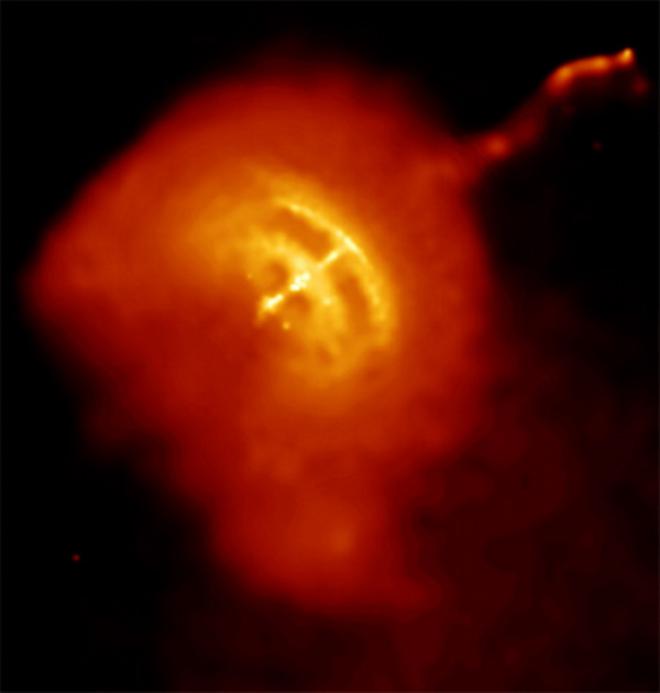The year was 1967. The Nathu La and Cho La clashes between the Indian and the Chinese armies had just concluded. A war was raging in Vietnam. The space race was at its peak. At this time, a group of astronomers at the University of Cambridge had put together an array of antennae for use as a telescope to study the radio waves emitted by distant stars.
When they started operating the array, two members of the group – Jocelyn Bell Burnell and Antony Hewish – noticed one set of signals that were flashing in a periodic manner. They didn’t know its origins.
We know today that the pair had discovered the first pulsar, named PSR B1919+21.
The pulsar and the neutron
The pulsar turned out to be intimately tied to a discovery from 1932, when James Chadwick had discovered the neutron. When neutrons are in a group, they are not allowed to have the same energies. Each neutron will have to settle for the lowest available energy level. If gravity tries to compress this collection of neutrons inward, their inability to ‘merge’ into a common energy level will resist with an outward pressure.
When heavy stars die, their cores implode. If they’re heavy enough, they become black holes; but if not, they collapse just enough to form a ball of neutrons, with gravity not being strong enough to overwhelm their outward pressure. This compact, super-dense object is called a neutron star.
When the Cambridge group reported that they had found a pulsar, other scientists proposed several possibilities for the origin of the unusual pulsating signal. Many of them were also rejected (including extraterrestrial civilisations). Ultimately, the fact that the signals came from a very small patch of the sky and that they repeated frequently led scientists to identifying pulsars as rotating neutron stars.
Radio signals emitted from near the poles of such a star would form a narrow cone that sweeps past the earth with every rotation – like the light from a lighthouse shining over a ship on the sea.
An animation depicting a pulsar’s lighthouse-like effect. Source: Michael Kramer (CC BY-SA 3.0)
A not-so-eureka moment
Soon, physicists found that the rotation of these neutron stars slowed over time, and then figured out why. They found that the energy ‘saved’ by reducing the rotation rate was used to accelerate electric charges outside the star, producing the radio signals.
This explanation was satisfying because it fit their theories so neatly – until they discovered a problem in 1969. Two research groups, working separately, reported an abrupt and brief increase in the rotation rate of the pulsar PSR 0833-45.
This glitch remains to be explained 44 years on, although physicists have some ideas. To date, they have spotted more than 3,000 pulsars and around 700 such glitches. The data they’ve accumulated plus some physics ideas have given rise to some hypotheses about what these glitches are, and why they happen.
A curious feature
When scientists plotted the rotation rate of pulsars over time on a graph, they saw the familiar decreasing pattern. During a glitch, the rate increases briefly before relaxing to the original value. They found this process to be quite slow. This is a big clue if we assume that the glitch is the result of something happening inside the star.
That is, if the inside of the neutron star was made primarily of regular matter, then all internal relative motions would be damped quickly by friction, in a matter of a few milliseconds. So the slow post-glitch relaxation hinted that the neutrons inside the star were in a slippery, frictionless state, which physicists called a superfluid.

Superfluids have peculiar properties. A superfluid set in motion inside a container will keep moving around. At a certain speed, a slender cylindrical portion will rotate in a vortex. As the container’s rotation rate is increased, more such vortices appear. The number of vortices – or their number density – determines how fast the fluid itself rotates. This has intriguing ramifications for the pulsar.
The origin of glitches
The neutron star is a 20-km-wide sphere with a solid crust and a core. The crust, believed to be a lattice of iron-like nuclei, is interspersed with neutron superfluid. The core predominantly contains the superfluid, and no solid parts.
The presence of the superfluid in a rotating system immediately implies the existence of vortices. As it happens, the vortices have less energy when they attach themselves to the nuclei in the crust than if they don’t. And all natural phenomena prefer to have less energy than more. The phenomenon of vortices ‘sticking’ to the nuclei is called pinning.
As the rotating neutron star loses energy to radiation, the crust slows down. On the other hand, the pinned vortices aren’t at liberty to rearrange themselves, which means the density of vortices remains unchanged and maintains the speed of the superfluid’s rotation.
The speed difference between the crust and the superfluid leads to a force on the vortices that eventually overcomes the pinning. At this point, the vortices are thrown outward, reducing the speed of the superfluid. The angular momentum lost by the superfluid is gained by the crust and this brief increase in rotation is reflected as a glitch in the pulsar timing data.
Note that several details of the glitching mechanism are greatly contested, including their trigger in space and the way they evolve over time. The topic is thus fertile bed for scientific inquiry – inquiry that could help us understand the variety of physics unfolding inside a neutron star.
As Ghalib said, “The stars are one thing and appear another, these tricksters fool us openly.”
The author is a fourth year PhD scholar in the Department of Physics at Ashoka University.







